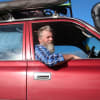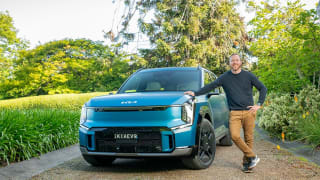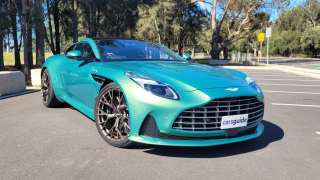While there will ultimately be four versions of the ID. Buzz, the fourth is a cargo-van layout, so we’ll deal with that one separately, elsewhere.
Which means the people-mover version will be available in three variants, starting with a five-seat short-wheelbase model called the Pro five-seater, as well as a long-wheelbase model called the Pro seven-seater.
Logical enough, but then there’s the range-topping long-wheelbase model which also gets you all-wheel drive and is called the GTX 4Motion.
However, that model won’t be showing up in the first batch, so the model we’re dealing with here is the Pro version in five and seven-seat formats.
Prices start at $87,990 for the five-seater and $91,290 for the Pro seven-seater, both before on-road costs
In Pro trim (five- or seven-seat) the vehicle gets a powered sliding door on each side, folding mirrors, a powered tailgate, tinted windows, keyless entry and start, stainless-steel pedal trims, 8.0x19 (front) and 9.0x19-inch alloy wheels (21-inch wheels are optional) height adjustable front seats, heated front seats, three-zone climate-control, wireless Apple CarPlay and Android Auto, a digital radio, dynamic LED matrix headlights, rain-sensing wipers, parking sensors and voice-control.
The major specification difference between the five and seven seaters is a move to larger brakes in the latter to reflect its higher kerb mass.
The flagship GTX model will add a new layer of luxury and convenience to that, but for now, it’s not slated to arrive here until early to mid-next year.
Like many lifestyle vehicles, the ID- Buzz is available with a raft of options, some conventional, others more in line with the retro theme on show.
There’s a panoramic sunroof option at $3290 and a stereo upgrade to a Harman Kardon unit which also brings a head-up display for the driver. That adds $2200 to the ticket.
There’s also an interior style package with bits and pieces you can add or subtract including luggage nets, different fabric trim, darker window tint and heated outer-rear seats. Tick all the boxes at that package adds $6470.
You can also choose the 'Premium Interior Style Package' with even ritzier trim and a $6970 tag.
But the options that best suit the theme here are the exterior paint choices. There’s metallic and pearl options at $1890 each, but the real hot-item is likely to be the $4090 two-tone paint treatment that takes us straight back to the glory days of hippies, Kombis and those epic two-tone paint jobs.





























































